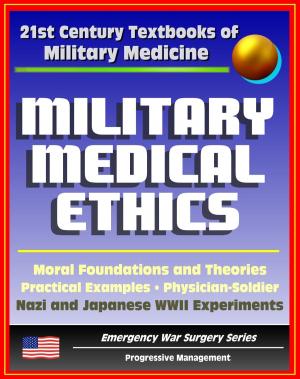NSA Secrets Declassified: Listening to the Rumrunners: Radio Intelligence during Prohibition, Cryptology, Elizebeth Friedman and USCG Thwart Rumrunners, Invisible Cryptologists: African-Americans
Nonfiction, History, Americas, United States, 20th Century, Social & Cultural Studies, Political Science| Author: | Progressive Management | ISBN: | 9781311730572 |
| Publisher: | Progressive Management | Publication: | April 6, 2015 |
| Imprint: | Smashwords Edition | Language: | English |
| Author: | Progressive Management |
| ISBN: | 9781311730572 |
| Publisher: | Progressive Management |
| Publication: | April 6, 2015 |
| Imprint: | Smashwords Edition |
| Language: | English |
Professionally converted for accurate flowing-text e-book format reproduction, three important NSA publications provide unique information about cryptology and radio intelligence used in the fight against rumrunners during Prohibition, and African-American cryptologists. Contents: Listening to the Rumrunners: Radio Intelligence during Prohibition; Cryptology, Elizebeth Friedman and the United States Coast Guard Thwart the Rumrunners; The Invisible Cryptologists: African-Americans, World War II to 1956.
Listening to the Rumrunners - Most Americans are aware of the era of lawlessness in this country that began with the passage of the Eighteenth Amendment to the Constitution in 1919. The institution of Prohibition brought with it major law enforcement problems, whose effects continue to be felt today. Few people, however, are aware of the major role played by communications intelligence in the enforcement of the Prohibition laws. The files of the United States Coast Guard (USCG) and the Federal Communications Commission (FCC), including the files of the Radio Division of the Department of Commerce, show that radio was used on a large scale in connection with rum-running activities. The radio operations of the rum-running organizations were, in fact, comparable in size, technical skill, and organization with the radio operation that would be conducted by enemy agents in World War II.
Cryptology, Elizebeth Friedman and the United States Coast Guard Thwart the Rumrunners - On land, the task of enforcing Prohibition fell to several federal agencies, but on the high seas, the responsibility belonged to the United States Coast Guard (USCG). This new responsibility would severely tax the Coast Guard's resources. They would have to police 12,000 miles of U.S. coastline with a total of 4,140 personnel and 75 vessels, the majority of which were not designed for law enforcement operations. Despite the difficulties presented by the mission, the Coast Guard accepted the challenge. The service's attitude was best expressed in a 25 April 1924 letter by RADM Frederick C. Billard, the USCG Commandant at the time, "The Coast Guard.. .will not fail in its performance of this... task. You men are the last line of defense..." However, in order to prevail in this effort they would need ingenuity, perseverance, and "a new kind of detective work," namely the art and science of cryptology.
The Invisible Cryptologists: African-Americans - During research on the early days of NSA, historians at the Center for Cryptologic History (CCH) learned of the employment of African-Americans at the Agency in the period after World War II. Occasionally, in informal conversations with former NSA seniors, the subject of minority history would come up, and CCH historians collected anecdotes about segregated offices in the early days. It became apparent that the employment of African-Americans came even earlier than previously thought. No information, however, confirmed any contribution by African-Americans during the world war. In early 1996, the History Center received as a donation a book of rather monotonous photographs of civilian employees at one of NSA's predecessors receiving citations for important contributions. Out of several hundred photographs, only two included African-Americans - an employee receiving an award from Colonel Preston Corderman and the same employee posing with his family. Although undated, the matrix of the photograph indicated it had been taken in 1945 or early 1946. This made it likely the person was receiving an award for wartime contributions. It therefore became a high priority in the History Center to investigate the story behind this photograph and learn the truth behind the unconnected anecdotes about African-Americans in the early days of the cryptologic organization.
Professionally converted for accurate flowing-text e-book format reproduction, three important NSA publications provide unique information about cryptology and radio intelligence used in the fight against rumrunners during Prohibition, and African-American cryptologists. Contents: Listening to the Rumrunners: Radio Intelligence during Prohibition; Cryptology, Elizebeth Friedman and the United States Coast Guard Thwart the Rumrunners; The Invisible Cryptologists: African-Americans, World War II to 1956.
Listening to the Rumrunners - Most Americans are aware of the era of lawlessness in this country that began with the passage of the Eighteenth Amendment to the Constitution in 1919. The institution of Prohibition brought with it major law enforcement problems, whose effects continue to be felt today. Few people, however, are aware of the major role played by communications intelligence in the enforcement of the Prohibition laws. The files of the United States Coast Guard (USCG) and the Federal Communications Commission (FCC), including the files of the Radio Division of the Department of Commerce, show that radio was used on a large scale in connection with rum-running activities. The radio operations of the rum-running organizations were, in fact, comparable in size, technical skill, and organization with the radio operation that would be conducted by enemy agents in World War II.
Cryptology, Elizebeth Friedman and the United States Coast Guard Thwart the Rumrunners - On land, the task of enforcing Prohibition fell to several federal agencies, but on the high seas, the responsibility belonged to the United States Coast Guard (USCG). This new responsibility would severely tax the Coast Guard's resources. They would have to police 12,000 miles of U.S. coastline with a total of 4,140 personnel and 75 vessels, the majority of which were not designed for law enforcement operations. Despite the difficulties presented by the mission, the Coast Guard accepted the challenge. The service's attitude was best expressed in a 25 April 1924 letter by RADM Frederick C. Billard, the USCG Commandant at the time, "The Coast Guard.. .will not fail in its performance of this... task. You men are the last line of defense..." However, in order to prevail in this effort they would need ingenuity, perseverance, and "a new kind of detective work," namely the art and science of cryptology.
The Invisible Cryptologists: African-Americans - During research on the early days of NSA, historians at the Center for Cryptologic History (CCH) learned of the employment of African-Americans at the Agency in the period after World War II. Occasionally, in informal conversations with former NSA seniors, the subject of minority history would come up, and CCH historians collected anecdotes about segregated offices in the early days. It became apparent that the employment of African-Americans came even earlier than previously thought. No information, however, confirmed any contribution by African-Americans during the world war. In early 1996, the History Center received as a donation a book of rather monotonous photographs of civilian employees at one of NSA's predecessors receiving citations for important contributions. Out of several hundred photographs, only two included African-Americans - an employee receiving an award from Colonel Preston Corderman and the same employee posing with his family. Although undated, the matrix of the photograph indicated it had been taken in 1945 or early 1946. This made it likely the person was receiving an award for wartime contributions. It therefore became a high priority in the History Center to investigate the story behind this photograph and learn the truth behind the unconnected anecdotes about African-Americans in the early days of the cryptologic organization.















